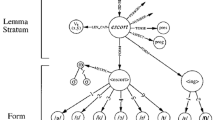Abstract
Three experiments demonstrate gender congruency effects (i.e., naming times of a picture are faster when the name of the target picture and a distractor noun are gender congruent) in Czech. In the first experiment, subjects named the pictures by producing gender-marked demonstrative pronouns and a noun. In the second and third experiments, subjects produced a gender-marked numeral (marked with a suffix) plus a noun. Two types of such suffixes exist in Czech. Some numerals vary in nominative singular with gender, others do not. The results show significant gender congruency effects in all experiments. They suggest that gender congruency effects can be obtained not only with free, but also with bound morphemes. In the second and third experiment the effect only emerged when the suffix was gender-marked (as opposed to gender-invariant), supporting the view that the gender congruency effect is due to competition at the level of phonological forms rather than at the grammatical level.
Similar content being viewed by others
References
Alario F.-X., Caramazza A. (2002) The production of determiners: Evidence from French. Cognition 82: 179–223
Beringer J. (1999) Experimental run time system. BeriSoft Cooperation, Frankfurt
Caramazza A. (1997) How many levels of processing are there in lexical access?. Cognitive Neuropsychology 14: 177–208
Caramazza A., Miozzo M., Costa A., Schiller N., Alario F.-X. (2001) Lexical selection: A cross-language investigation of determiner production. In: Dupoux E. (eds). Language, brain, and cognitive development: Essays in honor of Jacques Mehler. MIT Press, Cambridge, MA, pp. 209–226
Clahsen H. (1999) Lexical entries and rules of language: A multidisciplinary study of German inflection. Behavioral and Brain Sciences 22, 991–1060
Costa A., Sebastian-Galles N., Miozzo M., Caramazza A. (1999) The gender congruity effect: Evidence from Spanish and Catalan. Language and Cognitive Processes 14, 381–391
Costa A., Kovacic D., Fedorenko E., Caramazza A. (2003) The gender congruency effect and the selection of free-standing and bound morphemes: Evidence from Croatian. Journal of Experimental Psychology: Learning, Memory, and Cognition 29, 1270–1282
Dell G.S. (1986) A spreading-activation model of retrieval in sentence production. Psychological Review 93, 231–241
La Heij W., Mak P., Sander J., Willeboordse E. (1998) The gender congruency effect in picture-word tasks. Psychological Research 61, 209–219
Levelt W.J.M. (1989) Speaking: From intention to articulation. MIT Press, Cambridge
Levelt W.J.M., Roelofs A., Meyer A.S. (1999) A theory of lexical access in speech production. Behavioral and Brain Sciences 22, 1–75
Miozzo M., Caramazza A. (1999) The selection of determiners in noun phrase production. Journal of Experimental Psychology: Learning, Memory, and Cognition 25, 907–922
Pechmann T., Zerbst D. (2004) Syntactic constraints on lexical selection in language production. In: Pechmann T., Habel C. (eds). Multidisciplinary approaches to language production. Mouton, Berlin, pp. 279–303
Schiller N.O., Caramazza A. (2002) The selection of grammatical features in word production: The case of plural nouns in German. Brain and Language 81, 342–357
Schiller N.O., Caramazza A. (2003) Grammatical feature selection in noun phrase production: Evidence from German and Dutch. Journal of Memory and Language 48, 169–194
Schriefers H. (1993) Syntactic processes in the production of noun phrases. Journal of Experimental Psychology: Learning, Memory, and Cognition 19: 841–850
Schriefers H., Jescheniak J.D. (1999) Representation and processing of grammatical gender in language production: A review. Journal of Psycholinguistic Research 28, 575–600
Schriefers H., Jescheniak J.D., Hantsch A. (2002) Determiner selection in noun phrase production. Journal of Experimental Psychology: Learning, Memory, and Cognition 28, 941–950
Schriefers H., Jescheniak J.D., Hantsch A. (2005) Selection of gender-marked morphemes in speech production. Journal of Experimental Psychology: Learning, Memory, and Cognition 31, 159–168
Schriefers H., Teruel E. (2000) Grammatical gender in noun phrase production: The gender interference effect in German. Journal of Experimental Psychology: Learning, Memory, and Cognition, 26, 1368–1377
Stemberger J.P., MacWhinney B. (1986) Frequency and the storage of regularly inflected forms. Memory & Cognition 14, 17–26
Van Berkum J.J.A. (1997) Syntactic processes in speech production: The retrieval of grammatical gender. Cognition 64, 115–152
Author information
Authors and Affiliations
Corresponding author
Rights and permissions
About this article
Cite this article
Bordag, D., Pechmann, T. Grammatical Gender in Speech Production: Evidence from Czech. J Psycholinguist Res 37, 69–85 (2008). https://doi.org/10.1007/s10936-007-9060-0
Published:
Issue Date:
DOI: https://doi.org/10.1007/s10936-007-9060-0




